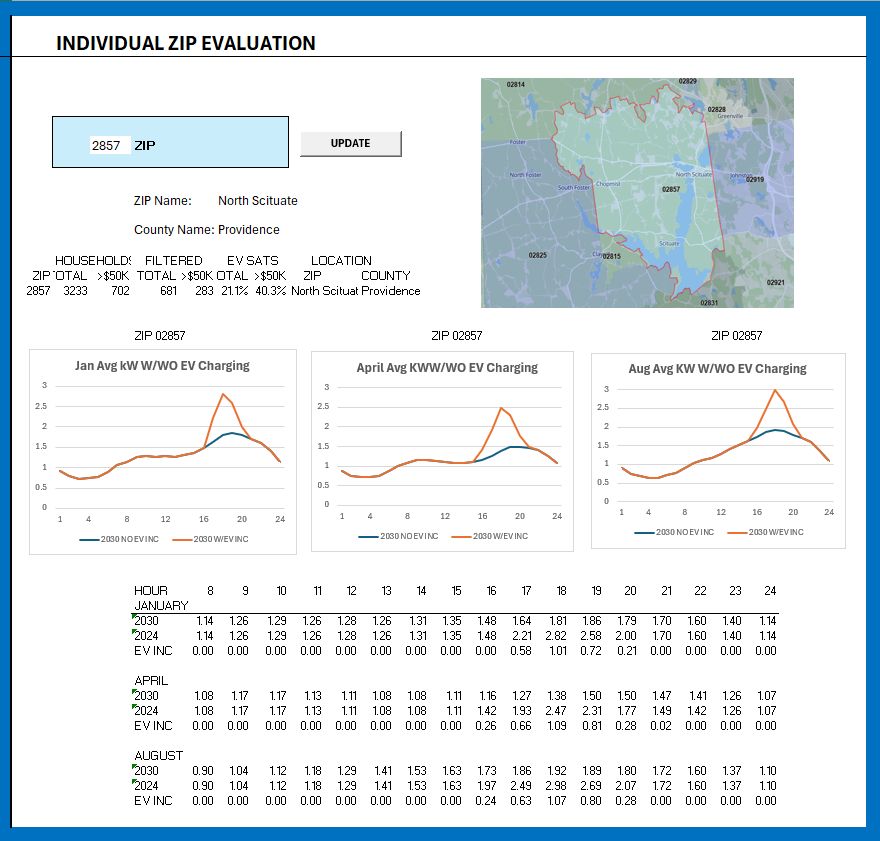| Smart Grid Research Consortium Digital Twin Models |
Next-Gen Models: Forecasting EV Loads with Digital Twins
Forecasting New Neighborhood Loads Requires New ToolsA critical new imperative for many utilities is forecasting the upsurge in small-area grid loads caused by rapidly growing EV ownership. Even more concerning, NREL estimates that 7 times more EVs will be on the road by 2030.The impact of EV load growth is a serious grid threat largely because EV ownership tends to cluster in smaller geographic areas characterized by household income, educational levels and other characteristics. Unanticipated grid overloading can cause low voltage, flickering lights, reduced transformer lifetimes and even blown transformers, not to mention customer complaints/dissatisfaction. EV impacts are even greater along older feeders operating near capacity. For example, the assistant director of Palo Alto utilities recently stated, “There are places even today where … we can’t even have one EV charger go in.” Forecasting these neighborhood-level loads requires an entirely new set of tools well beyond traditional utility system-wide energy and peak modeling methodologies. Digital twin modeling is a new forecasting technology that is increasingly being used to model and analyze electric utility physical distribution components. Digital twin models are virtual representations of physical assets like transformers, substations, and feeders using physical equipment characteristics along with data from sensors as feedback to simulate equipment behavior, condition, and performance. Digital twin EV impact modeling includes physical, income and demographic data for actual individual utility customers that identifies likely new EV owners, estimates EV grid load impacts and models utility EV program impacts over time. Digital twin EV models are a subclass of agent-based models, a technique that models behavior of individual decision-makers (agents). This modeling approach has been applied for decades in various industries including electric utilities. Digital twin models are distinguished from the more general agent-based characterization by incorporating a feedback data loop to update and refine EV choice, loads and program impact model components. The remainder of this paper provides a general description of the development of a digital twin EV impact model. The final section describes a new digital twin EV Grid Impact Model developed by the Smart Grid Research Consortium. Utility Customer EV Grid Impact Modeling: A New Digital Twin ApplicationA starting point for developing a digital twin EV grid impact model is to acquire or develop a database with detailed information on actual utility customers. Rather than developing this information on every residential customer, a statistically valid alternative is to develop data on a much smaller sample of actual utility customers. Analysis based on the statistical sample provides nearly identical results at a small fraction of the cost required to develop data for each customer.Income, educational level, commuting characteristics, demographics, appliance holdings, 8760 hourly loads and other data items are required for each utility customer in the population sample. It’s important to use the most accurate customer data sources available because individual customer EV ownership forecasts are determined by applying these data in an AI K Nearest Neighbor process that matches utility customer characteristics to a calibration EV ownership data set with the same variables. Baseline hourly loads, EV purchase decisions, resulting charging loads and load shifting program impacts are forecast for each utility customer in the sample for each year in the forecast period. Utility customer EV owner 8760 hourly loads reflect baseline hourly loads plus charging loads; utility customers without EVs reflect only baseline 8760 hourly loads. Data on each customer’s forecast hourly loads can be aggregated across utility customers for any geographic region of interest, for customer segments based on income or other characteristics for each forecast year. These forecast grid impacts can be compared to existing grid capabilities to identify strategies to integrate utility load control programs with grid upgrades to accommodate new peak period loads. An Example: The SGRC Grid Impact ModelThe Smart Grid Research Consortium’s Grid Impact Model (GIM) provides an example of a digital twin EV grid impact model.Individual utility customer income, demographics, dwelling unit, commuting data and hourly loads data are provided by the MAISY Utility Customer Energy Use and Hourly Loads Database. Three empirical relationships are included in the modeling process: 
The SGRC Grid Impact Model also includes grid hourly load impacts of extreme weather on space heating and air conditioning loads and impacts of all-electric new buildings and renovations. ConclusionA critical new imperative for many utilities is forecasting the upsurge in small-area grid loads caused by rapidly growing EV ownership. Unanticipated grid overloading can cause low voltage, flickering lights, reduced transformer lifetimes and even blown transformers, not to mention customer complaints/ dissatisfaction.Forecasting these neighborhood-level loads requires an entirely new set of tools well beyond traditional utility system-wide energy and peak modeling methodologies. Digital twin modeling, a new forecasting technology that is increasingly being used to model and analyze electric utility distribution equipment, is a perfect application to forecast these small areas EV grid threats. EV digital twin modeling applies information on actual utility customers identifying new EV ownership and grid load impacts and results of load-shifting utility programs. Models are updated periodically to r efine customer ownership, loads and utility program model relationships based on actual household information. |
Related Topics
|